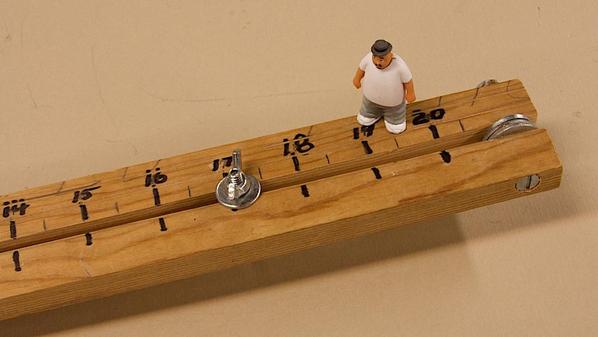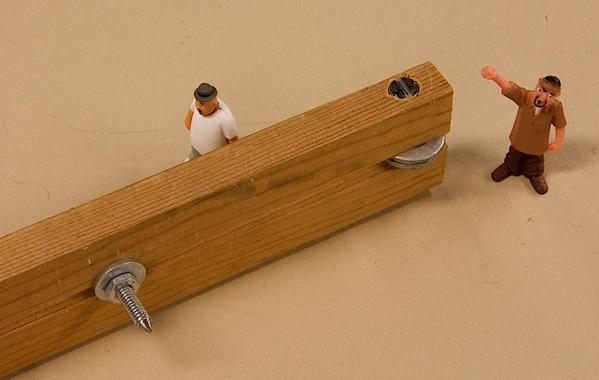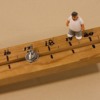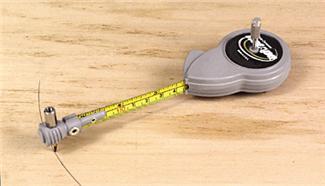Thanks
Thanks
Replies sorted oldest to newest
either method will work, but I would not use string. I use a metal yardstick with holes for each popular diameter. Sometimes i'll freehand, other times I use a jig saw setup that I made myself-- it's a "chinese clone" of a commercially available jig. (i'm a cheapskate ![]() ). don't own a router, yet.
). don't own a router, yet.
String and pencil is accurate enough for train work. As for "best", if you're using
flex track you will be able to put easements on the straight/curve transitions. For that, you can use a program like AnyRail and print out a 1:1 template and use
that with a scroll saw or router.
-Mark
A homemade compass is used for drawing the arcs. The cutting is done with a saber saw. This is a smaller compass for tight curves. I also have a much longer one for wide curves. ![]()
Jim
Attachments
Jim, now we know the secret to your success! You have help! ![]() Russ
Russ
I bought the Rotape from MicroMark. It's a tape measure that has a pencil lead holder at the tape end and a steel center post on the spool end. You simply pull the tape out to the radius desired and scribe the arc. I would suggest using a helper to keep the pin in the wood once you're out beyond arm's reach to both ends. Used this to lay out the curves on the rebuild. I then used the first curved pieces to do the rest of them so I didn't have to worry about arc centers that fell off the ply sheets.
Once the curves were drawn, I used a saber saw for all curves and a circular saw for all tangents. Since scenery is going to go against all curved roadbed edges, the smoothness of the curves wasn't a critical issue.
Attachments
That's right, Russ!
Couldn't do it without the little guys. ![]()
![]()
Jim
I use a homemade compass, too, but it's nowhere near as slick as Jim's:
I just drill holes in a wooden yardstick. I drill a hole at 1" and insert a wood screw: this is the pivot point. Then I just drill holes as needed for other radii, remembering to add 1" to everything--so an O-36 gets a hole at 19", for example.
Naturally, this will not work for O-72 or larger curves, but, then, what's to stop one from taping two yardsticks together!!! Nothing but our fear of greatness, I say!
Thanks, I really appreciate the responses. All my curves are 072 or larger.
Woogie
I use a homemade compass, too, but it's nowhere near as slick as Jim's:
I just drill holes in a wooden yardstick. I drill a hole at 1" and insert a wood screw: this is the pivot point. Then I just drill holes as needed for other radii, remembering to add 1" to everything--so an O-36 gets a hole at 19", for example.
Naturally, this will not work for O-72 or larger curves, but, then, what's to stop one from taping two yardsticks together!!! Nothing but our fear of greatness, I say!
If you can get hold of a "meter stick" that will cover an O-72 centerline + 2 inches using your technique above. They sell them at some educational supply stores. My high school chem and physics teachers had them.
"All my curves are 072 or larger." Also remember if you are cutting for your roadbed to add at least a half an inch or so each side for attaching scenery materials. This will insure you have enough room for clearance. Just a thought. I also use the yard stick method. Good thread here! Russ
I am a huge fan of the rotape, i have used it and loved it! It is always the right lenght instead of having to creat a seperate patern for each radius if you do not want to deal with the overhang. Woodcraft also sells it.
I use a very expensive high-tech system (ha!). I sink a small nail, cut a small notch in each end of a wooden yarstick, place one notch against the nail and put a pencil in the other end. That gives you a O72 diameter curve. For smaller curves, drill a hole at the proper measurement. For larger curves I clamp another yardstick extension to the end. Simple but effective.
I draw my roadbed using CAD software then plot it out at a 1 : 1 scale then glue this to the board or foam and cut it out. This way I can get perfect spirals into my curves and out to the tangents.
Sorry for the delay...we took a Labor Day trip back East to visit family.
That sounds like a terrific idea, but it would cost me a bundle in ink and paper... not counting the scotch tape to hold all the letter-sized sheets together.
During the last two weeks, I've been building a Berkshire Valley 40s gas station. It wasn't supposed to be a big deal since I was hoping to work on it with my younger grandson, but it wasn't as easy to create as I thought and I've ended up building it instead of building the railroad.
I tried using a PC Projector to project the ply images from the computer (done in CorelDraw), but it distorted the image too much, the OSB sheets were too badly bowed to hold a straight image, so I scrapped the idea and went back to laying out the sheets using the Rotape and some templates.
Some of the more advanced Rotozip kits have a rotating cutting attachment. I had to alter the tool to cut a circle this big. Getting the circle center just right took some time.
Trainman2001, if you would like to try my method e-mail the dimensions of at least a section of your track and I will plot this and mail it to you (maximum 42" x 20') or e-mail it back and you could have someone locally plot it. bamawhiteman@yahoo.com














